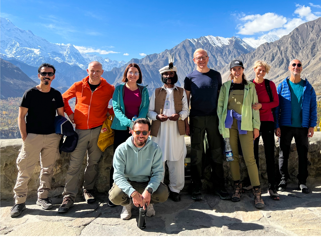Baltit Fort
Baltit Fort is situated in Karimabad, once was the capital of the state of Hunza, now Tehsil Headquarters of District Gilgit. It is approached by Karakoram Highway from Gilgit, the capital of Northern Areas, Pakistan.
The Baltit Fort stands on an artificially flattened spur below the Ultar Glacier. Strategically located with a commanding view of the Hunza Valley and its Tributaries, its inhabitants controlled the seasonal trans-Karakoram trade between south and Central Asia. The Baltit Fort is rectangular in plan with three floors and stands on a high stone plinth Fig-I. The ground floor consists mainly of storage chambers, the first floor is oriented around an open hall. A staircase leads to the second floor which was mainly used during the winter months and contains an audience hall, guest room, dining hall, kitchen, and servants’ quarters. A further staircase leads up to the third floor, which is partly open to the elements and contains the summer dining room, audience chamber, bedroom, and reception hall.

The Mirs of Hunza abandoned the fort in 1945 and moved to a new palace down the hill. The fort started to decay which caused concern that it might possibly fall into ruin. Following a survey by the Royal Geographical Society of London, a restoration programme was initiated and supported by the Aga Khan Trust for Culture Historic Cities Support Programme. The conservation work carried out in the 1990s indicated that the core of the structures, a single defensive timber and stone tower, had been built in the eighth century A.D. This tower was augmented by additional towers and linked by a single-story construction consisting of small rooms and sub-surface storage chambers. The complex was then later expanded by the addition of a second, and then a third floor. The structure’s stone walls, built in an area of frequent seismic movements, were provided with a traditional internal framework of timber for greater stabilization.
The programme was completed in 1996, and the fort is now a museum run by the Baltit Heritage Trust. It has been on the UNESCO World Heritage Tentative List since 2004.
Baltit Fort is well known for its amazing location, beautiful view, and ancient architecture in Gilgit and Baltistan.
 SALAH UD DIN
SALAH UD DIN
The renowned guardian of Baltit Fort in Karimabad, Hunza. His magnificent moustache and warmly sincere eyes make quite the impression. Ironically he appears quite serious in his pictures. He grew his signature Marco Polo moustache in 24 years.
 HUNZA CANON
HUNZA CANON
Aka Zilizila Boos. This canon was manufactured in around 1869-70, during the reign of Mir Ghazan Khan I, under the command of Wazir Asadullah Baig, by acquiring the services of gun makers of Badakhshan through a successful negotiation by the well-known envoy Arbab Ali Johar of Ghulkin village Gojal (Upper Hunza). Every household of Hunza donated a piece of brass home utensil & charcoal.

